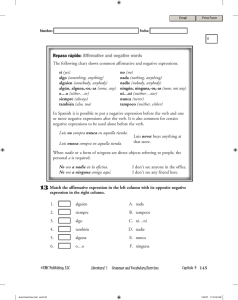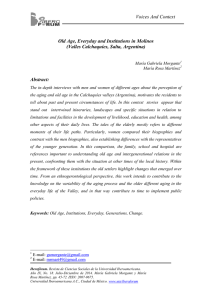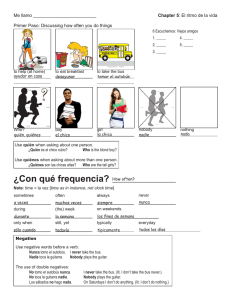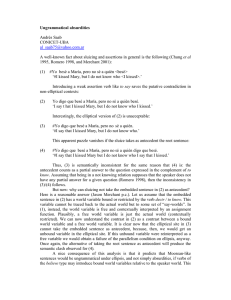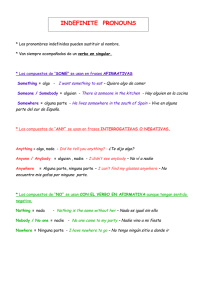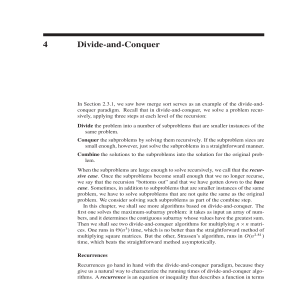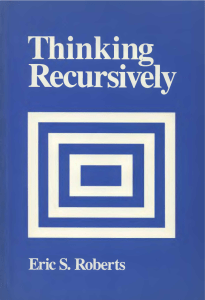Who is afraid of constructivism
Anuncio
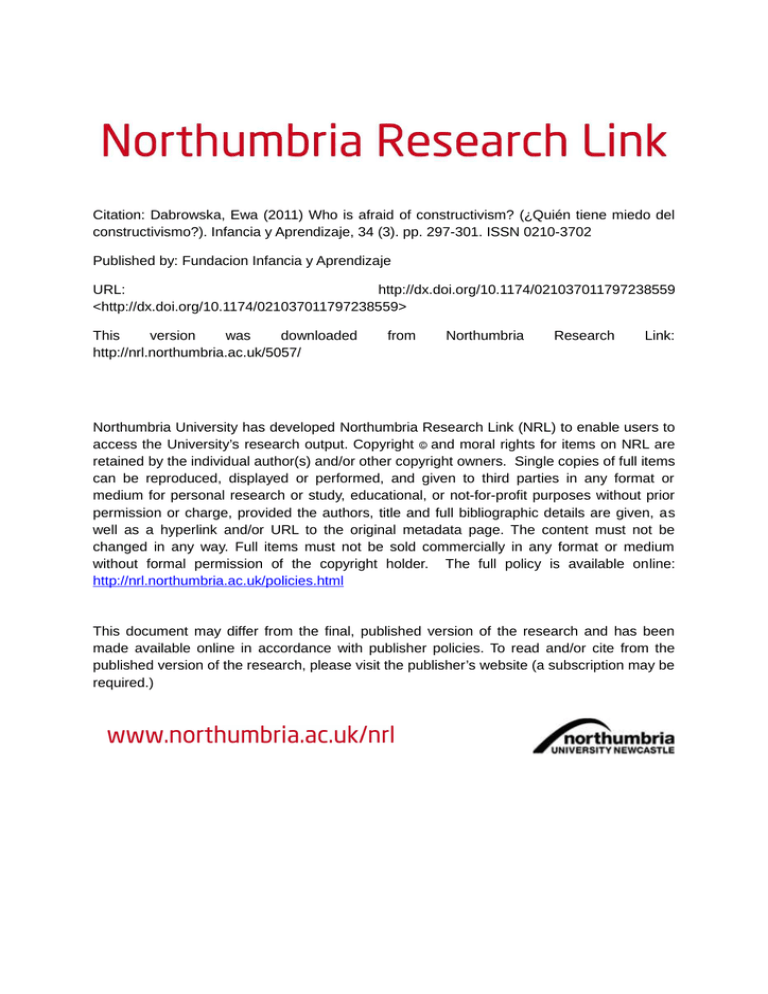
Citation: Dabrowska, Ewa (2011) Who is afraid of constructivism? (¿Quién tiene miedo del constructivismo?). Infancia y Aprendizaje, 34 (3). pp. 297-301. ISSN 0210-3702 Published by: Fundacion Infancia y Aprendizaje URL: http://dx.doi.org/10.1174/021037011797238559 <http://dx.doi.org/10.1174/021037011797238559> This version was downloaded http://nrl.northumbria.ac.uk/5057/ from Northumbria Research Link: Northumbria University has developed Northumbria Research Link (NRL) to enable users to access the University’s research output. Copyright © and moral rights for items on NRL are retained by the individual author(s) and/or other copyright owners. Single copies of full items can be reproduced, displayed or performed, and given to third parties in any format or medium for personal research or study, educational, or not-for-profit purposes without prior permission or charge, provided the authors, title and full bibliographic details are given, as well as a hyperlink and/or URL to the original metadata page. The content must not be changed in any way. Full items must not be sold commercially in any format or medium without formal permission of the copyright holder. The full policy is available online: http://nrl.northumbria.ac.uk/policies.html This document may differ from the final, published version of the research and has been made available online in accordance with publisher policies. To read and/or cite from the published version of the research, please visit the publisher’s website (a subscription may be required.) Infancia y Aprendizaje 34 (2011), 297-301 © Fundación Infancia y Aprendizaje Who is afraid of constructivism? Ewa Dąbrowska Northumbria University The authors of the two position papers on constructivist and generative theories of language acquisition approach their task in very different ways, perhaps indicative of the way constructivists and generativists approach the problems of acquisition. Lieven & Brandt (henceforth L&B) devote most of their paper to substantiating two crucial claims of the constructivist approach: that children’s earliest constructions are lexically specific and become more abstract (and more productive) as development proceeds; and that the properties of children’s grammars are strongly influenced by properties of the input such as frequency. Roeper & Pérez-Leroux (R&PL) begin by contrasting “abstract syntax” and “simple syntax”. The former position claims that children’s production is characterised from the very beginning by “abstraction, generative capacity, and principled behavior” (p. 2). Proponents of simple syntax, R&PL claim, deny that this is the case; and they go on to insist that the presence of these properties entails innate linguistic representations of the kind postulated by generativist researchers. It is clear that Roeper and Pérez-Leroux do not understand the constructivist approach. Their criticism, I will argue in this commentary, is largely misdirected. More importantly, however, their own argument is a non sequitor: the fact that children demonstrate the ability to form abstractions and produce novel grammatically patterned utterances does not entail the existence of an innate Universal Grammar. Abstraction and generative capacity It is true that constructivist researchers like Lieven and Brandt believe that children’s grammatical representations are largely lexically specific (as opposed to abstract) and that their productivity, in the early stages of development, is quite limited – but this is not the same as saying that children lack abstraction or generative capacity. L&B explicitly acknowledge that “children are capable of abstraction from the beginning of language, and, in fact, before this” (p. 3) and that they combine words productively from a very young age (p. 4). However, both abstraction and productivity are matters of degree. L&B, as well as other constructivists (e.g. Tomasello 2000, 2003), cite a considerable amount of evidence demonstrating that children’s grammars manifest these properties to a lesser extent than those of adults and that development towards more abstract representations is slow and piecemeal (in the sense that knowledge about a particular linguistic category in one construction doesn’t necessarily immediately generalize to other constructions). To demonstrate the validity of the Abstract Syntax position, it is not enough to produce evidence of early abstraction and productivity: one would also need to demonstrate that children’s representations are as abstract as those of adults. Principled behaviour Generativist researchers emphasise that children’s linguistic production is target-like from the very beginning: errors are relatively infrequent (considering the extremely large number of potential errors that could be made) and they are, by and large, “reasonable”, in the sense that they are plausible extensions of the patterns found in the language the child is learning, or instantiations of patterns found in other languages. The textbook example of this is the fact that children don’t postulate structure-independent rules like “to form a question, move the first auxiliary to the beginning of the sentence”, which would produce ungrammatical sentences such as *Is the man who _ singing is your dad?, even though such a rule would be 2 simpler than the correct structure-dependent rule (“to form a question, move the first auxiliary after the subject to the beginning of the sentence”). L&B point out that by the time children begin to produce sentences relevant to the argument (i.e., sentences with a relative clause modifying the subject noun), they have already had plenty of opportunities to learn that noun phrases are expressions with a particular linguistic function (picking out a referent) and that it is the whole noun phrase as a unit that accomplishes this function. More importantly, we would only expect errors of this kind if we assume that questions are formed by moving the auxiliary from the preverbal position to the beginning of the sentence. In a constructivist framework, questions are formed just like all other constructions: by inserting new material into an existing template (such as is REF REF?, or BE REF REF?, where REF stands for referring expression, i.e. a noun phrase). This does not involve movement, so there is no possibility of elements from the subordinate clause, or from any other part of the sentence, to “move” to inappropriate positions. R&PL provide their own example of principled behaviour apparently governed by abstract rules: negative concord in Spanish. Negative phrases in Spanish are used on their own when they come before the verb (Nadie vino ‘Nobody came’) and with the particle no when they follow the verb (No vino nadie ‘Nobody came’); structures such as *Nadie no vino are ungrammatical. To explain this, R&PL assume that “when the indefinite negative raises above the polarity head, it checks its features by movement. If unchecked, the features are spelled out in situ as no.” (11) Thus, presumably, the fact that children do not produce sentences such as *nadie no vino is to be regarded as evidence they have tacit knowledge of raising, movement, and checking. Note, however, that we do not need to appeal to such concepts to explain the nonoccurrence of this type of error: the same data can be easily captured in a constructivist framework. Spanish has two negative constructions: NEG V (acquired by generalizing over 3 sentences such as Nadie vino ‘Nobody came’, Nada prometen ‘They promise nothing’) and No V NEG (acquired by generalizing over No vino nadie, No prometen nada). Children don’t produce *Nadie no vino, *Nada no prometen because the corresponding pattern (*NEG no V) is not attested in the input. Actually, things are a little more complicated (and more interesting) if we take a closer look at the use of negation in the María corpus (López Ornat 1994), which R&PL use to illustrate their argument. In María’s speech, nada ‘nothing’ and nadie ‘nobody’ occur only in the No V NEG construction, while nunca ‘never’ occurs initially only in the NEG V construction. The corpus also contains a single instance of nunca in the other construction (pero ya no voy a poner nunca más mi radio ‘but I’m not going to turn my radio on ever again’), produced relatively late – at age 3;10. This suggests that María’s constructional inventory does not yet contain fully general constructions with a general NEG slot, but more lexically specific ones, viz. No V nada No V nadie Nunca V and, from 3;10, No V nunca. This closely mirrors the patterns found in the input, and hence is fully compatible with a constructivist account, but difficult to accommodate in a framework that postulates abstract rules and principles. Properties of the input also explain another fact that puzzles R&PL, namely, why English-learning children do not have a final negation stage (cf. p. 10). The short answer is that they don’t systematically produce negation-final utterances because such utterances do not occur in their input, while Spanish-speaking children hear utterances of the form X+no 4 approximately once every fifteen minutes. Utterance-final no may account for only 10% of the uses of the negative particle in Spanish, but it is 10% of a very large number, since the particle no is very frequent. In fact, it is the most frequent word in the input: there are 2240 instances of adult no in the María corpus, which comprises approximately 58 hours of speech. This means that no occurred, on average, 39 times per hour in María’s input; and utterance final no 3.9 times per hour. Incidentally, R&PL use the early emergence of utterance-final no in María’s speech to argue against the claim that input frequency is a good predictor of order of emergence, asserting that it is the first negative construction to appear in María’s speech, in spite of the fact that it is considerably less frequent than other uses of the particle. It is not clear on what basis they arrived at the conclusion that utterance final no emerges first. The earliest examples of this construction that they cite were produced at age 1;9; but utterance-initial and medial negation is also attested in the child’s speech during this period, and even earlier: the first fourteen transcripts in the corpus, all recorded at age 1;7, contain 14 instances of clause-initial negation and 8 instances of no in the clause-medial position. Recursion Section 2 of R&PL’s contribution is devoted to demonstrating that human languages use recursion. Recursion is a slippery term. As the authors acknowledge, there are different types of recursion. There is also considerable debate about the exact sense in which grammars are recursive and whether or not recursion in language is really unbounded (Christiansen and MacDonald 2009, Evans and Levinson 2009, Karlsson 2007). What R&PL mean by recursion is hierarchical structure – the fact that linguistic expressions consist of smaller constituents and, as a special case, smaller constituents of the same type as the mother node. 5 Once again, this is fully compatible with constructivist approaches such as that outlined by L&B. A slot in a frame can be elaborated by a complex constituent, e.g. the REF slot in where’s REF? can be filled by expressions such as the book about dinosaurs or the book you bought for Mike. Such structures are emergent rather than predefined, flatter than traditional phrase structure trees and fluid in the sense there is often more than one way of assembling a particular expression (cf. Dąbrowska and Lieven 2005). However, as argued by Langacker (1997), such an approach to constituency is well motivated and avoids many of the problems encountered by traditional constituency hierarchies. R&PL also point out that recursion is acquired on a structure-by-structure basis, that there are crosslinguistic differences in which structures are used recursively, and that some aspects of recursion pose problems for children and are acquired relatively late. These facts are problematic for the generative framework: if recursion is no more than the consequence of the universal operation Merge, all recursive structures should emerge at the same time and there should be no crosslinguistic differences. On the other hand, developmental asynchronies and crosslinguistic differences can be easily accommodated in constructivist approaches, according to which the ability to form hierarchically organised structures is a result of discovering slots in previously acquired units (I want an apple → I want REF). Crucially, different slots emerge at different times (Lieven, Salomo and Tomasello 2009); and hence one would expect recursive structures to be acquired in a piecemeal manner as well. Final comments R&PL go beyond the nativist orthodoxy in that they recognise that linking is a problem for nativist theories and acknowledge that some structures take considerable time to develop. In their conclusion, however, they revert to a very traditional argument: “Given that all human languages have hierarchical, asymmetrical concatenated structures, it is more sensible to posit 6 continuous access to this fundamental property by children, since to date no theories have been articulated as to how such properties might emerge from experience” (30). In other words: we have no theory of how some aspects of language are learned; therefore it’s best to conclude that they are innate. This kind of approach does not solve the problem of how language is acquired, but merely postpones it (cf. Dąbrowska 2004): rather than explaining how human children come to have language, we must now explain how humans as a species came to have Universal Grammar – and we certainly have no satisfactory theory of this. In fact we can use a similar argument to argue the opposite: we have no theory of how UG could have evolved; therefore, it’s better to assume that it did not, and that human children learn language from the input. Note that this is merely a working assumption rather than a basic premise on which the entire theory of language acquisition is constructed. If it turns out that some aspects of language cannot be acquired without specifically linguistic innate representations, the theory will need to be revised; but this would not invalidate the vast amount of research suggesting that most of the structures that children use can in fact be learned using the basic cognitive skills that we know that they have. More to the point: we do have a very promising theory of how languages are learned from the input, outlined in the Lieven & Brandt contribution, and developed more fully by Tomasello (2003) and a host of other publications. Unfortunately, Roeper and Pérez-Leroux simply do not engage with it. References Christiansen, M. H., & MacDonald, M. C. (2009). A usage-based approach to recursion in sentence processing. Language Learning, 59, 126 - 161. Dąbrowska, E. (2004). Language, Mind and Brain. Some Psychological and Neurological Constraints on Theories of Grammar. Edinburgh: Edinburgh University Press. 7 Dąbrowska, E., & Lieven, E. (2005). Towards a lexically specific grammar of children's question constructions. Cognitive Linguistics, 16, 437–474. Evans, N., & Levinson, S. (2009). The myth of language universals. Behavioral and Brain Sciences, 32, 429-492. Karlsson, F. (2007). Constraints on multiple center-embedding of clauses. Journal of Linguistics, 43, 365-392. Langacker, R. W. (1997). Constituency, dependency, and conceptual grouping. Cognitive Linguistics, 8, 1-32. Lieven, E., Salomo, D., & Tomasello, M. (2009). Two-year-old children's production of multiword utterances: A usage-based analysis. Cognitive Linguistics, 20, 481-508. López Ornat, S. (1994). La adquisición de la lengua Española. Madrid: Siglo XXI. Tomasello, M. (2000). The item-based nature of children's early syntactic development. Trends in Cognitive Science, 4, 156-163. Tomasello, M. (2003). Constructing a Language: A Usage-Based Theory of Child Language Acquisition. Cambridge, MA: Harvard University Press. 8

